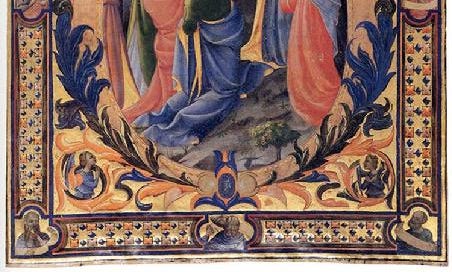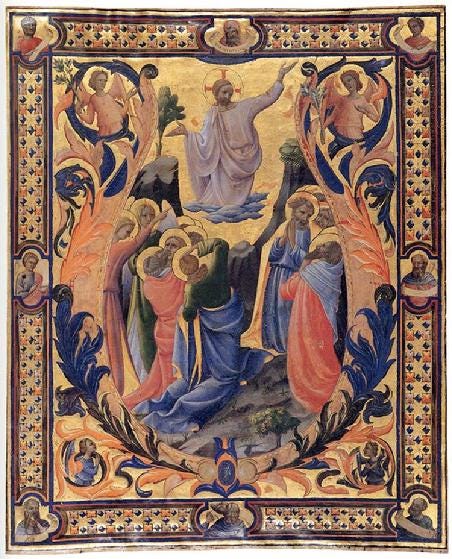Acts 1:1-11
In the first book, Theophilus, I wrote about all that Jesus did and taught from the beginning until the day when he was taken up to heaven, after giving instructions through the Holy Spirit to the apostles whom he had chosen. After his suffering he presented himself alive to them by many convincing proofs, appearing to them during forty days and speaking about the kingdom of God. While staying with them, he ordered them not to leave Jerusalem, but to wait there for the promise of the Father. "This," he said, "is what you have heard from me; for John baptized with water, but you will be baptized with the Holy Spirit not many days from now."
So when they had come together, they asked him, "Lord, is this the time when you will restore the kingdom to Israel?" He replied, "It is not for you to know the times or periods that the Father has set by his own authority. But you will receive power when the Holy Spirit has come upon you; and you will be my witnesses in Jerusalem, in all Judea and Samaria, and to the ends of the earth." When he had said this, as they were watching, he was lifted up, and a cloud took him out of their sight. While he was going and they were gazing up toward heaven, suddenly two men in white robes stood by them. They said, "Men of Galilee, why do you stand looking up toward heaven? This Jesus, who has been taken up from you into heaven, will come in the same way as you saw him go into heaven."
QUIRKY PAINTINGS OF CHRIST’S ASCENSION by Pamela Cranston Hans Süss von Kulmbach’s Ascension makes me laugh. Two feet hang down like pale chandeliers just below the top of the frame over the heads of Mary his mother and the twelve apostles (or eleven men with Magdalene hiding in the crowd), all adoring, not God or Jesus ascending, but two punctured duck-feet. Maybe Hans ran out of room or he’d have imagined Jesus rising in glory, like a future Franky Zapata lifting above the Champs Elysees jet-propelled on his hover board, waving goodbye in benediction on his way to his heavenly throne. More mind-bending is Dali’s Ascension. Two large soles of Christ’s feet, now healed, float close to the viewer. Christ rises (arms outstretched, his hands contorted, frozen in agony), toward the head of a giant sunflower, the golden nucleus of life, to join Spirit-dove and God the Mother. Dali places the viewer right where the apostles stood, beneath the feet of Christ as he floats above and beyond. Whenever I see this, I can barely stand—but I wonder what was it like to watch him leave (for the second time) as he rose? After he was gone, when in grief they looked down, did they see his footprints in the dust? © Pamela Cranston, The House of Metaphor (Eugene, OR: Wipf and Stock/Resource Publications, 2023.)
Hans Süss von Kulmbach’s The Ascension of Christ, 1513, German
Salvadore Dali, The Ascension of Christ, 1958, Spain
This past Thursday Christian churches throughout the world celebrated the Feast of Christ’s Ascension. Forty days after Jesus’ resurrection, Jesus and his disciples climbed up the Mount of Olives where Jesus commissioned his disciples to baptize all people in His name. Then suddenly Jesus was lifted up and removed from their sight. Gone just like that.
The disciples had already endured the crucifixion which was a devastating, brutal tragedy. But then, Jesus reappeared – alive! The risen Jesus showed himself to his followers repeatedly for forty days. Now they were faced with losing him once again. Jesus tried to explain it to them at the Last Supper; that it was for their good he was going away, for only then the Spirit could come and be with them always.
Most of us have a hard time with saying good-bye—whether it is letting a daughter go off to 1st grade or college for the first time, or a son into military service, or saying good-bye in an unwanted divorce or retirement or death. This is why good-byes makes such good fodder for movies.
Barbara Brown Taylor once said in a sermon:
Ascension Day is the day the present Lord became absent, which may be why it is the most forgotten feast day of the church year. Who wants to celebrate being left behind? Who wants to mark the day that Jesus went out of this world, never to be seen again? Hungry as we are for the presence of God, the one thing we do not need is a day to remind us of God's absence.[1]
This week, I have been thinking a great deal about two pictures of Christ’s Ascension. The first is by the German painter Hans Süss von Kulmbach, painted in 1513. The painting depicts eleven disciples standing or kneeling in prayer as Jesus ascends. But the only thing the viewer sees are two duck feet of Jesus, containing the marks of the nails, and the bottom of his red robe hanging from the top of the frame. Nothing else.
I have to admit, I find this painting pretty funny though I am sure it was painted with the utmost reverence. Did Hans run out of canvas or did he hate his rendition of the ascending Christ so much that he chopped him off at the knees? What’s more, there is a half-hidden face among the disciples who could very well have been Mary Magdalene. And while we’re at it, since when did Jesus stop wearing white? Did he, with his usual foresight, change his fashion choice to red because of the upcoming Feast of Pentecost?
The second painting is by the surrealist Spanish painter Salvador Dali called “The Ascension of Christ”. This painting views the Ascension from the disciples’ point of view – from below, looking up at the soles of Jesus’ feet as he rises up. Jesus is going to God (who is represented here by a woman, who happened to be Dali’s wife Gala.) And at the bottom of the painting, on the sea shore, there is an empty fishing boat, left behind because the disciples are now catching men and women – not fish.
There is a famous Ascension scene in the movies – can anyone guess what movie it's in? It's E.T. Nothing quite captures the emotional impact of the Ascension as the final scene from Steven Spielberg’s movie E.T. If you ever saw the movie, you’d think Stephen Spielberg lifted whole sections of the Bible to create it, complete with Noah’s rainbow, death and resurrection scenes, and E.T. bearing the burning-red sacred heart of Jesus.
For the two people on this planet who haven’t seen this fabulous movie, E.T. is about an adorable Extra-terrestrial being who finds himself abandoned one night by his spacecraft in a Los Angeles suburb where he hides in a shed in young Elliot's back yard. The boy discovers him then hides and protects him in his own home where E.T. hotwires the family telephone to phone home to his local space craft and experiences several mishaps.
Spoiler alert, in the course of the movie E.T. dies and then rises again, and then after trying to phone home many times, his space craft finally returns. At the end, they say good-bye, standing by the waiting aircraft (like Humphrey Bogart and Ingrid Bergman in Casa Blanca.)
E.T. the Extra-Terrestrial, ©Steven Spielberg, Amblin Entertainment, 1982.E.T. takes his pot of resurrected flowers, turns and waddles from side to side like Charlie Chaplin as he ascends up the gangplank into his spaceship. Elliot and his family weep and wave good-bye as the triumphal music of John Williams swells, the space hovers, and then flies away at the speed of light to some distant galaxy far, far away.
We tend to think of the Ascension as the time when Jesus went away, when he left us behind. But I think that in the Ascension, Jesus didn’t leave the world, he went more deeply into it and into us. Jesus says to us, like E.T.: “I am going away but I will be right here.”
As St. Augustine put it, “You ascended from before our eyes, and we turned back grieving, only to find you in our hearts.”
I will tell you a secret of the resurrection. St. Paul and St. Augustine didn’t simply mean this figuratively—they meant it quite literally. The resurrected Jesus moves among us and in us. His tangible but invisible presence can show up at unexpected times, standing among us, standing behind us, laying tangible hands on our shoulders, literally moving from one body to the next as if each one of us was a separate house for his Presence—which we are.
This is why another painting, a woodcut, by the Catholic Worker artist Fritz Eichenberg called Christ of the Breadline, has always haunted me.
Fritz Eichenberg, “Christ of the Breadline", The Catholic Worker, 1950
Eichenberg depicts Jesus standing in a breadline during the Great Depression, hiding in plain view. It reminds us of Jesus’ quote: “The least you did to these you did to me.”
Here again we see that Jesus still walks on this earth—able to materialize at any time, any place, in any guise or manner he wants but always unrecognized. Jesus could not do this unless he had moved in a wider dimension when he had ascended.
Jesus’ disciples weren’t ready for this—weren’t ready for Jesus dying on Good Friday, weren’t ready for the Resurrection, nor for the Ascension, and you can be sure they weren’t ready for Pentecost—but it all happened anyway. God did this to change us and send us out to do Love's work in the world. We are the only hands, the only feet, the only hearts Jesus has as instruments to use.
As Annie Dillard wrote in her book Holy the Firm: “Who shall ascend the hill of the Lord? Or who shall stand in his holy place? There is no one but us. There is no one to send, nor a clean hand nor a pure heart on the face of the earth, but only us, a generation comforting ourselves with the notion that we have come at an awkward time…our children busy and troubled, we ourselves unfit, not yet ready, but there is no one but us. There never has been.”[2]
The good news is that we don’t have to do this alone.
[1] Taylor, Barbara Brown. “The Day We Were Left Behind.” Christianity Today, May 18, 1998.
[2] Dillard, Annie, Holy the Firm (New York: Harper & Row, 1977) p. 56-7.
The Ascension, Monaco Lorenzo, antiphonary, c.1410









What a lovely, colorful sermon in words and art!! Tim
Thanks Tim.